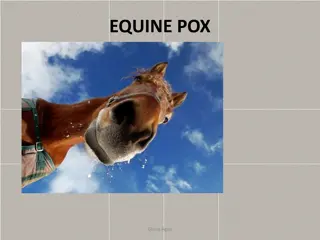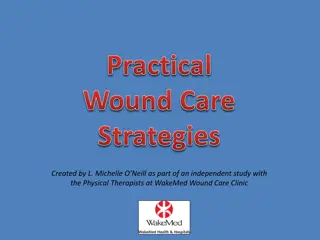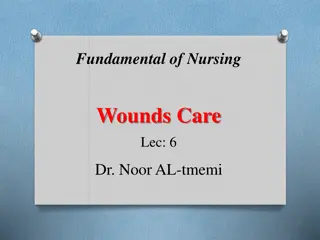Basic Equine Wound Care: Understanding and Treatment
Learn about basic equine wound care, including initial steps to take, stages of the healing process, types of wounds, and treatment options. Understand how to assess the severity of wounds and the importance of proper care to prevent complications. This guide provides valuable information for horse owners and caretakers.
Download Presentation

Please find below an Image/Link to download the presentation.
The content on the website is provided AS IS for your information and personal use only. It may not be sold, licensed, or shared on other websites without obtaining consent from the author.If you encounter any issues during the download, it is possible that the publisher has removed the file from their server.
You are allowed to download the files provided on this website for personal or commercial use, subject to the condition that they are used lawfully. All files are the property of their respective owners.
The content on the website is provided AS IS for your information and personal use only. It may not be sold, licensed, or shared on other websites without obtaining consent from the author.
E N D
Presentation Transcript
OHIO STATE UNIVERSITY EXTENSION Basic Equine Wound Care Timothy McDermott DVM Ag/NR Hocking Co.
OHIO STATE UNIVERSITY EXTENSION What to do first Do not get injured Calm horse get inside Call Vet What can you do to help? Stop bleeding Gently irrigate wound Bandage Get First Aid material 2
OHIO STATE UNIVERSITY EXTENSION The Healing Process Stages of Healing Inflammation Proliferation/Epithelialization Remodeling Types of closure Primary closure Delayed Primary debridement Second Intention Most tensile strength at 7-14 days, Total strength is 15% less 3
OHIO STATE UNIVERSITY EXTENSION Types of wounds Puncture wounds Small Deep Abrasions Lacerations Shallow Deep Linear vs Flap Eyes 4
OHIO STATE UNIVERSITY EXTENSION Puncture Wounds Is it bleeding? A lot? Gushing? Deep vs Shallow Where is the puncture located? A small puncture over a synovial structure can be worse than a large laceration over the rump or shoulder. Synovial Puncture = TRUE EMERGENCY Good prognosis with timely and correct care 5
OHIO STATE UNIVERSITY EXTENSION Assess how bad the damage is Does not have the reputation punctures and lacerations do Fly/Insect secondary damage. Need to prevent them from getting worse. Abrasions 6
OHIO STATE UNIVERSITY EXTENSION Assess similarly to a puncture wound Bleeding, location, depth A laceration involving tendons, joints or large blood vessels is a TRUE EMERGENCY http://priorsequine.co.uk/wp-content/uploads/2015/11/wounds.jpg http://2.bp.blogspot.com/-dBgLdxILjkE/VO8guXlvzcI/AAAAAAAABbw/yENMpjrVgWk/s1600/leg-cuts.jpg Lacerations 7
OHIO STATE UNIVERSITY EXTENSION Treatment options - medical Topical therapy Saline flush for debris Antiseptics Antibiotics Other Honey, Silver, Hydrogel, etc. Insect repellants Oral therapy Antibiotics Pain reliever IV/Hospitalization Bandages, eye covers, splints 8
OHIO STATE UNIVERSITY EXTENSION What is proud flesh Part of the normal healing process Formation of granulation tissue More common in horses than other species More common on lower leg Skin under tension Need a management plan Prevention is best, start on DAY ONE Stall rest, bandaging, cleaning, ointments Photo credit: Dr. Holly Beckford, theequinevet.com Work with Vet to determine individual plan Balance too much and too little granulation tissue to get just right https://theequinevet.files.wordpress.com/2011/07/p21400391.jpg?w=600h=450 9
OHIO STATE UNIVERSITY EXTENSION Kansas St University FOUR C s 1. Stay Calm 2. Clean the Wound 3. Compression bandage 4. Call the Vet 10
OHIO STATE UNIVERSITY EXTENSION Questions? 11























